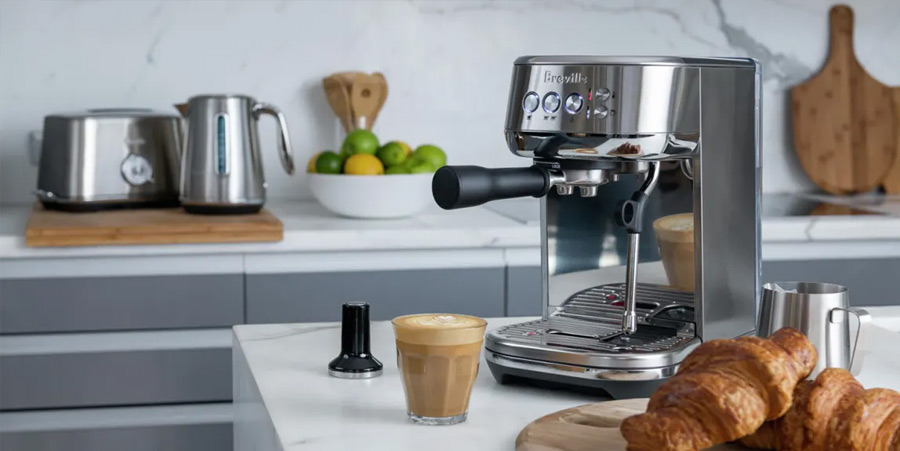A macchiato is a beautiful thing. It’s the marriage of a rich, fruity espresso and just a spot of frothed milk to stretch the flavor across your tongue—the equivalent of dropping an ice cube into scotch. It’s also the exact coffee drink that I haven’t been able to have in months. (Instead, I’ve been supporting my favorite Chicago roaster by ordering countless pounds of beans by mail.)
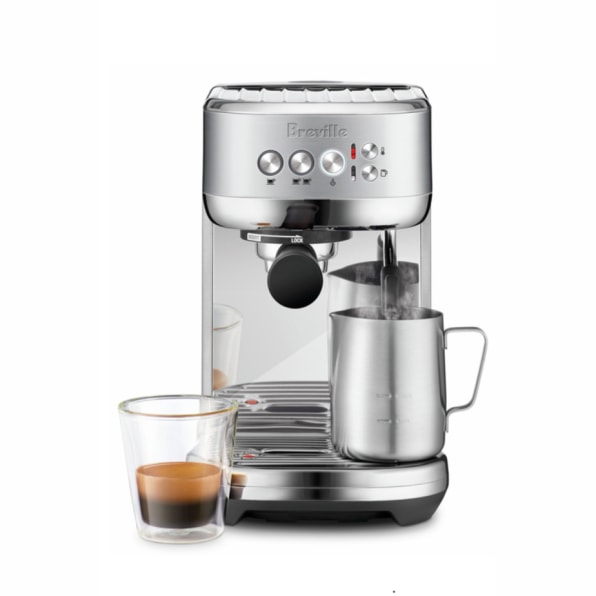
That is, until I pulled the Breville Bambino Plus ($499) out of the box—a true espresso maker with a counter-friendly footprint that’s just 7.6 inches wide, or about the size of a hotel room Keurig. That’s right. Even though it’s small, there are no strange pods or flavor capsules behind this machine. It even features the exact same pressure and water heating technology as Breville espresso makers that cost nearly twice as much (in cash and counter real estate). And it’s a master class in countertop UX, combining just the right amounts of automation and do-it-yourself magic.I elbow my Instant Pot and Zojirushi rice maker to the side to make some space. As I grind my first batch of beans—Intelligentsia’s classic Black Cat espresso—I look at the machine skeptically. “It’s just too tiny to be any good!” I think, prepping myself for mediocrity.

Then I pull out the portafilter (that’s the filter handle you always see baristas messing around with) and feel its surprising heft for its tiny size. I fill the basket with ground beans and tamp it down tight with a bundled tool. I give a small grunt as I twist it into the machine. I hit a button, wait three seconds for the water to heat up, and then I hear it begin to pump.
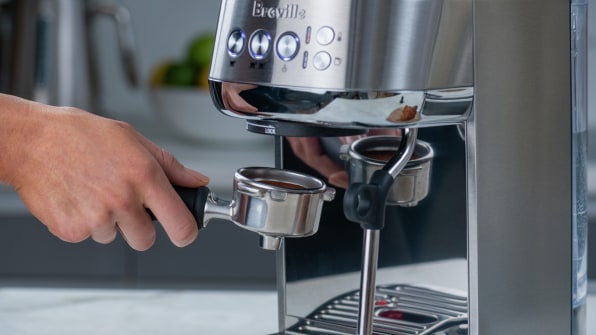
Less than 20 seconds later, I take my first sip, expecting swill since I’ve never pulled a shot before. That’s when I realize, I’m sipping a respectable, surprisingly satisfying cup of espresso—toasted but not bitter, and topped with a gorgeous crema. I immediately glance to the steam wand. Macchiato, you’re next.
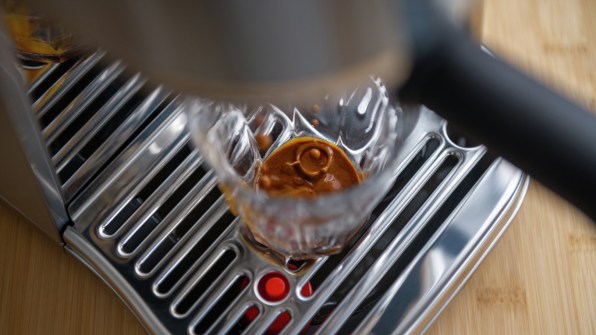
A few days later, I hop on a call with Phil McKnight, Breville’s global business manager of beverage, who I’m told is also the company’s “coffee guru.” McKnight confirms to me what all the spec sheets on Breville’s website claim: The Bambino has all of the same crucial systems that are in its espresso makers that run up to $1200, and it was designed for a new market, a crunched consumer who doesn’t have a lot of cash.“The challenge for us was, how do we put all the [necessary]systems and components into a machine with a really compact footprint,” he says. “It’s suiting what’s happening everywhere in the world, with a mushrooming of apartment living. There’s a lot more compact living spaces, so we need to provide appliances that suit modern living arrangements these days.”

The Bambino Plus has the same hefty, steel portafilter of more expensive models. It has the same 15-bar pressure pump and accompanying release valve, which ultimately allows the Bambino to produce 9-bar extraction—that’s nine atmospheres of pressure, the same recommended espresso pressure recommended by the World Barista Championship, a major international competition in the coffee world. (Why a 15-bar pump in a 9-bar machine? Reliability, says McKnight, like having a car that can redline at 140 mph so it’s comfortable cruising at 70 mph on the highway.) It has the same “thermojet” water heating technology, which lets you make espresso in just three seconds after plugging in the machine. And it has the same milk-frothing steam wand that can operate automatically, doing the job for you if you haven’t learned the art or don’t care to. (Sensors track your milk’s heat, while algorithms ensure proper frothiness.)Over the course of a week, I make more espresso. I’m delighted to see how easy it is to clean (the entire bottom tray slips in and out instantly to dump out spills, and the steam wand auto-purges after use so it won’t clog up.) One of the most difficult tasks is simply figuring out how to wrap my body around the light machine to anchor it down as I tighten in the portafilter. I found that forgivable, since as I dial in the right grind, the espresso goes from good to borderline transcendent, catching the complicated, fruity notes that are so celebrated in third-wave coffee.
I also try my hand at frothing milk. To use the automatic milk frothing, you pour some milk in a cup, hit a button, and let the steam wand go. For my stabilizer-free soy milk, the auto mode worked but not quite perfectly. The bottom of the pitcher had the microbubbles I wanted for a macchiato, but the top was foam. When McKnight hears this, he’s not completely surprised. He lets me in on a secret: The company’s future espresso machines are going to have auto settings for all the plant-based milks too.
So after watching a couple YouTube videos, I tried frothing for myself, tilting the cup to create a whirlpool of milk, knowing it was done when my hand started to get too hot to hold the carafe. I carefully poured the milk over the espresso, attempting to make a heart on top.
How do those 20-year-olds wearing Warby Parkers make it look so easy? But you know what, who cares? The macchiato itself tasted just right.
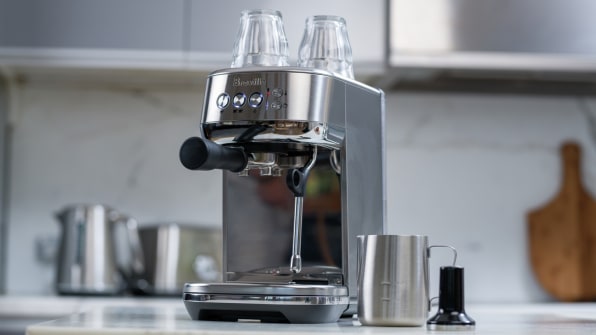
The more I use the Bambino Plus, the more I appreciate its balanced approach to UX. The machine is filled with automatic settings that almost promise you can’t I Love Lucy your coffee. But every time I twist in that portafilter, or steam a cup of milk by hand, I get to cosplay barista and enjoy a sense of accomplishment that a fully auto espresso maker (as glorious as that can be) just doesn’t offer.
Is this experience by design? “It’s one of our key objectives,” says McKnight. “To make sure any consumer can be as engaged as they would want to be, but there’s no obligation to have that level of engagement if you don’t want to. If you want to master latte art, you can manually texture milk and be the barista at home without us forcing you down that path.”
As I sip on my 30,000th macchiato of the day (though I still can’t make the stupid heart!), I think about Breville’s approach to cooking appliances compared with that of the Silicon Valley smart oven startup June. June has attempted to leverage AI to replace human knowledge in the cooking process, but Breville offers you the opportunity to hone your craft, learn new skills, and feel worthwhile—even though automation deserves part of the credit.
The Bambino Plus is available now for $499. But if you’re willing to give up the auto milk frothing and settle for a lighter portafilter (made of nickel instead of steel), Breville just released a $299 Bambino that is otherwise identical to the Plus. Given that every button and component on each of these products is tested individually 14,600 times to simulate 10 years of use, I can’t imagine you can go wrong either way. Though for the $200 you can save on the base model, you could buy 10-plus pounds of premium espresso beans. Or in my case, a few classes on making latte art.
This article first appeared in www.fastcompany.com

